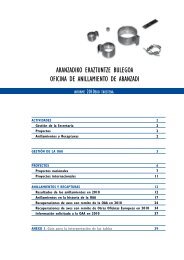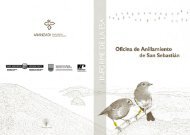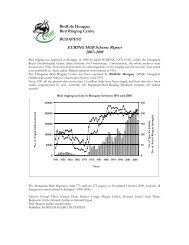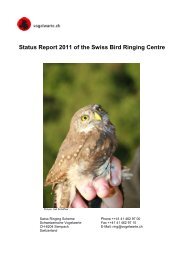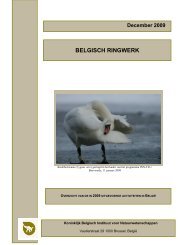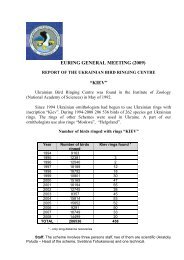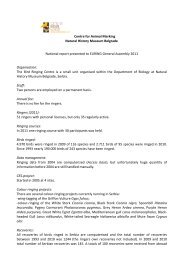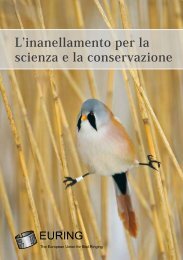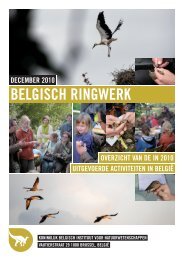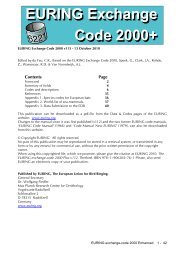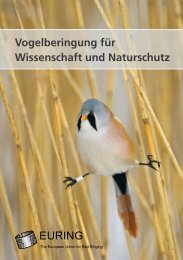Bird Ringing for Science and Conservation - The European Union ...
Bird Ringing for Science and Conservation - The European Union ...
Bird Ringing for Science and Conservation - The European Union ...
- No tags were found...
Create successful ePaper yourself
Turn your PDF publications into a flip-book with our unique Google optimized e-Paper software.
<strong>Bird</strong> <strong>Ringing</strong> <strong>for</strong> <strong>Science</strong> <strong>and</strong> <strong>Conservation</strong><br />
<strong>Bird</strong> <strong>Ringing</strong> <strong>for</strong> <strong>Science</strong> <strong>and</strong> <strong>Conservation</strong><br />
<strong>Ringing</strong> birds to underst<strong>and</strong> population dynamics<br />
Underst<strong>and</strong>ing the mechanisms underpinning<br />
population growth <strong>and</strong> decline<br />
is central <strong>for</strong> conservation <strong>and</strong> many ecological<br />
<strong>and</strong> evolutionary questions. <strong>The</strong><br />
variation of the size of a population from<br />
one year to another is determined by the<br />
number of individuals that have survived,<br />
were recruited, have immigrated or emigrated.<br />
Estimates of survival, recruitment,<br />
immigration <strong>and</strong> emigration rates<br />
can be obtained, if the fate of individuals<br />
can be followed through time <strong>and</strong> space.<br />
<strong>Bird</strong>s that are ringed can be recognized<br />
individually allowing to estimate demographic<br />
rates.<br />
However, the estimation of demographic<br />
rates is complicated by the fact<br />
that marked individuals cannot always<br />
be observed. Some individuals may be<br />
hidden at the time when the researcher<br />
wants to check them. Consequently, only<br />
fragments of the life of a ringed bird are<br />
known, <strong>and</strong> statistical methods have to<br />
be developed to deal with this problem.<br />
Technical meetings regularly organised<br />
by EURING deal mainly with this challenge,<br />
<strong>and</strong> they have helped considerably<br />
to advance statistical methods. Nowadays,<br />
sophisticated computer programs<br />
exist with which demographic rates can<br />
be estimated from capture-recapture<br />
data or from data from dead recoveries.<br />
Here we highlight three different studies<br />
showing the potential of data, gathered<br />
from ringed birds, to underst<strong>and</strong> population<br />
dynamics.<br />
<strong>The</strong>re are many studies about survival<br />
rates in birds obtained from either capture-recapture<br />
data or from recoveries of<br />
dead individuals. Several of them have<br />
shown that survival rates of migratory<br />
birds depend on the availability of food<br />
Greater Flamingos, the 3rd individual to the right wearing a colour ring.<br />
Jean-Lou Zimmermann<br />
resources during the non-breeding period.<br />
For example, annual survival rates<br />
of White Storks are significantly lower<br />
in years with droughts in the Sahel. Because<br />
White Storks from most <strong>European</strong><br />
populations spend the non-breeding period<br />
at least partially in the Sahel, the<br />
sensitivity to droughts can explain why<br />
population changes across large areas in<br />
the <strong>European</strong> breeding area are synchronous.<br />
Moreover, this example highlights<br />
that successful conservation needs to integrate<br />
the complete life cycle of the species<br />
under question, not only the breeding<br />
period.<br />
Recruitment, the establishment of locally<br />
hatched individuals in the population,<br />
is important <strong>for</strong> the maintenance of<br />
a population. To underst<strong>and</strong> the impact<br />
of recruitment on population dynamics it<br />
must be known at which age young birds<br />
Willow Tit<br />
Tero Niemi<br />
breed <strong>for</strong> the first time <strong>and</strong> how many<br />
there are. <strong>The</strong>se questions can be studied<br />
if nestlings are marked <strong>and</strong> if it is noted<br />
in which year they reproduce. Researchers<br />
from France have studied recruitment<br />
in Flamingos in the Camargue. <strong>The</strong> first<br />
individuals started to breed at the age<br />
of 3 years, but there were also individuals<br />
that delayed their first breeding up to<br />
an age of 9 years. Recruitment was higher<br />
in years following a severe winter with<br />
higher mortality, showing that the effects<br />
of strong winters are offset by earlier recruitment,<br />
which reduces the impact of<br />
hard winter on population dynamics.<br />
In order to underst<strong>and</strong> population<br />
dynamics, it is vital to be able to assess<br />
how much variation in survival, reproduction<br />
or dispersal contribute to population<br />
change. Surviving adults of Willow<br />
Tits contributed 64 % to the growth rate<br />
of a Finish population, whereas the contribution<br />
due to immigration (22 %) <strong>and</strong><br />
due to local recruitment (14 %) were significantly<br />
lower. <strong>The</strong> contribution of surviving<br />
adults was constant across time,<br />
but highly variable <strong>for</strong> local recruits<br />
<strong>and</strong> immigrants. Thus, the dynamics of<br />
this willow tit population were mainly<br />
due to variation in recruitment <strong>and</strong> immigration.<br />
However, because surviving<br />
adults contribute so much to population<br />
growth, any slight decline in adult survival<br />
rate has a very strong effect on the<br />
population.<br />
All these insights were only possible,<br />
because birds have been ringed. Without<br />
individual recognition of birds in a<br />
population, it is hardly possible to underst<strong>and</strong><br />
demographic reasons <strong>for</strong> population<br />
changes. <strong>Bird</strong> ringing is there<strong>for</strong>e<br />
the basic field method to study population<br />
declines <strong>and</strong> increases.<br />
18<br />
19



